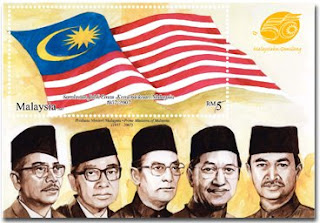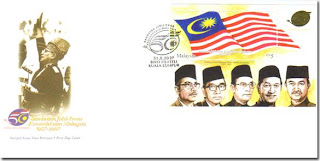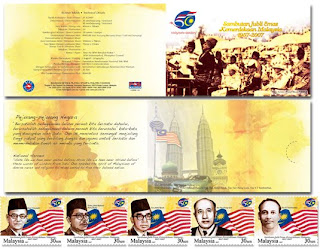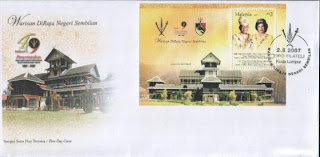 A delegation led by Tunku Abdul Rahman Putra Al-Haj headed off to London in January 1956 with a mission entrusted by the people of Malaya to negotiate for the country's independence. The negotiation was successful and the Merdeka cry was heard throughout Malaya on 31st August 1957. It was the new beginning for a nation that had been under the domination of foreign powers for more than 446 years.
A delegation led by Tunku Abdul Rahman Putra Al-Haj headed off to London in January 1956 with a mission entrusted by the people of Malaya to negotiate for the country's independence. The negotiation was successful and the Merdeka cry was heard throughout Malaya on 31st August 1957. It was the new beginning for a nation that had been under the domination of foreign powers for more than 446 years.Today, after 50 years of independence, we have achieved advancements in various fields. We are no longer a colony and we have moved forward based on our own aspirations and under our constitutional democracy system. It is hoped that the peace and harmony that are currently
 enjoyed by 26 million Malaysians from various background, ethnicity and creed would continue to be the pride of future generations.
enjoyed by 26 million Malaysians from various background, ethnicity and creed would continue to be the pride of future generations.The first 50 sen stamp brings back a moment in the nation's history on how it all began. It depicts Tunku Abdul Rahman Putra Al-Haj signing the Declaration of Independence that became the biggest milestone in the nation's history. The historical event validated the sovereignty of Malaya and marked the starting point for the country as a free and independent nation. The replica of the historic document is shown in the background.
The second 50 sen stamp celebrates the
 achievement of our nation after 50 years of independence. It depicts the logo of the Golden Jubilee celebration of Malaysia's Independence to commemorate the 50 years of our nation's sovereignty. The logo was designed based on the National Flag, known as "Jalur Gemilang", symbolizing the pride of the people of Malaysia.
achievement of our nation after 50 years of independence. It depicts the logo of the Golden Jubilee celebration of Malaysia's Independence to commemorate the 50 years of our nation's sovereignty. The logo was designed based on the National Flag, known as "Jalur Gemilang", symbolizing the pride of the people of Malaysia.This first 30 sen stamp depicts the historical Sultan Abdul Samad building that witnessed the bringing down of the British Government flag,
 "The Union Jack" at midnight of 30th August 1957 at the Selangor Club Field (now known as Merdeka Square) to signify the end of British Colonial era. In the center, it features the legendary leader, Tunku Abdul Rahman Putra Al-Haj during significant moment when he declared the independence of Malaya at Stadium Merdeka in the morning of 31st August 1957. His historic "Merdeka" cries sparked off a celebration throughout the nation. Also featured are
"The Union Jack" at midnight of 30th August 1957 at the Selangor Club Field (now known as Merdeka Square) to signify the end of British Colonial era. In the center, it features the legendary leader, Tunku Abdul Rahman Putra Al-Haj during significant moment when he declared the independence of Malaya at Stadium Merdeka in the morning of 31st August 1957. His historic "Merdeka" cries sparked off a celebration throughout the nation. Also featured are  Parliament Building as the symbol of the nation's sovereignty, the strength of the Government of Malaysia and its constitutions as well as the National Monument as the symbol of the struggle and sacrifice by the people to defend the nation.
Parliament Building as the symbol of the nation's sovereignty, the strength of the Government of Malaysia and its constitutions as well as the National Monument as the symbol of the struggle and sacrifice by the people to defend the nation.The second 30 sen stamp reflects the nation's achievement after 50 years of independence. It depicts the Petronas Twin Towers, Kuala Lumpur Tower, the Government's administrative building at Putrajaya, the national car and Penang bridge, where all of these symbolizes our achievement as a modern and developing country under our strong, capable, and visionary leaders.
The miniature sheet is a tribute to the strong, capable and visionary leaders of the past and present who contribute endlessly to shape the
 nation to be what it is today. The upper part of the sheet depicts the pride of the people of Malaysia, the national flag, known as "Jalur Gemilang".
nation to be what it is today. The upper part of the sheet depicts the pride of the people of Malaysia, the national flag, known as "Jalur Gemilang".The lower part features the Prime Ministers who had strived to ensure the continuity of the country's sovereignty as a free and independent nation.
 Technical Details
Technical DetailsDate of Issue : 31-Aug-2007
Denomination : 30 Sen ( setenant), 50 Sen (Setenant)
Sheet Content : 20
Stamp Size : 40mm x 30mm
Miniature Sheet Value : RM 5.00
Miniature Sheet Size : 100mm x 70mm
Stamp Size in Miniature Sheet : 70mm x 35mm
 Perforation : 14
Perforation : 14Stamps Paper : SPM Watermarked, Phosphor Coated
Printing Process : Lithography
Printer : Percetakan Keselamatan Nasional Sdn Bhd
Stamp Designer : Jari Seni Communications and Kementerian Kebudayaan, Kesenian dan Warisan Malaysia
First Day Cover Value : 30 Sen
Presentation Pack Value : RM 4.00
Stamp Booklet Value : RM 3.00
Folder Value : RM 5.00
POS Malaysia 29 August 2007 , Wednesday Press Release
POS MALAYSIA LAUNCHED STAMP AND FIRST DAY COVER TO COMMEMORATE MALAYSIA’S GOLDEN JUBILEE CELEBRATION OF ITS INDEPENDENCE
As the nation celebrates its 50th anniversary of its independence, Pos Malaysia will issue a special collection of Merdeka stamps and First Day Cover on 31 August 2007. The Stamps and First Day Cover were launched today by YB Dato’ Wong Kam Hoong, Deputy Minister of Culture, Art and Heritage Malaysia at Kompleks Kraf Kuala Lumpur. The special collection of Merdeka stamps and First Day Cover will feature images that evoke the nostalgia of Malaysia’s struggle for independence, the notable leaders who helped shape the face of our country as well as patriotic images to inspire the sense of pride and appreciation of our nation’s accomplishments.
Our struggle to achieve independence had gone through a long and winding journey filled with challenges. In the end, all was made possible by the determination and commitment demonstrated by our rulers, leaders and nationalists in carrying out their duties and responsibilities for their beloved nation, people and religion.
A delegation led by Tunku Abdul Rahman Putra Al-Haj headed off to London in January 1956 with a mission entrusted by the people of Malaya to negotiate for the country’s independence. The negotiation was successful and the Merdeka cry was heard throughout Malaya on 31st August 1957. It was the new beginning for a nation that had been under the domination of foreign powers for more than 400 years.
Today, after 50 years of independence, Malaysia has achieved advancements in various fields. The country is no longer a colony and has moved forward based on our own aspirations and under our constitutional democracy system. It is hoped that the peace and harmony that are currently enjoyed by 26 million Malaysians from various backgrounds, ethnicity and creed would continue to be the pride of future generations.
“The first stamp issued after Malaysia achieved its independence was on 31 August 1957 and 50 years later, we are commemorating the historic occasion of the golden jubilee of Merdeka through the issuance of Merdeka Stamps and First Day Cover. This is indeed a momentous occasion for Pos Malaysia and we are very honoured for the opportunity to be part of the celebration of Malaysia’s 50 years of nationhood,” said Dato’ Idrose Mohamed, Managing Director of Pos Malaysia Berhad.
“Over the span of 50 years, Malaysia has gained so much in terms of modernization, industrialization, social as well as economic development and, as a unique country that is a melting pot of culture and ethnicity, there is a lot to talk about our beloved country. The issuance of the Merdeka Stamps and First Day Cover is a tribute to the nation’s aspirations and celebrates our development and achievements. We hope that stamp collectors as well as all Malaysians will take the opportunity to purchase the Merdeka Stamps and First Day Cover as a way to express their sense of pride of the nation’s past and triumphs as well as to be kept as a token of remembrance to be shared with the future generation,” Dato’ Idrose added.
The stamps, 40mm x 30mm in size are printed in sheets of 20 on SPM watermarked, phosphor coated paper and are available in 2 designs for 30sen denomination (setenant) and 2 designs for 50sen denomination (setenant). The description of the stamp designs are as follows :
- 30sen : Sultan Abdul Samad Building, Merdeka Square, Parliament Building & the National Monument This 30 sen stamp depicts the historical Sultan Abdul Samad building that witnessed the bringing down of the British Government flag, “The Union Jack” at midnight of 30th August 1957 at the Selangor Club Field (now known as Merdeka Square) to signify the end of British Colonial era. In the centre, it features the legendary leader, Tunku Abdul Rahman Putra Al-Haj during significant moment when he declared the independence of Malaya at Stadium Merdeka in the morning of 31 August 1957. His historic “Merdeka” cries sparked off a celebration throughout the nation. Also featured are Parliament Building as the symbol of the nation’s sovereignty, the strength of the Government of Malaysia and its constitutions as well as the National Monument as the symbol of the struggle and sacrifice by the people to defend the nation.
- 30sen : Petronas Twin Towers, KL Tower, Government’s Administrative Building in Putrajaya, the National Car & Penang Bridge This 30 sen stamp reflects the nation’s achievement after 50 years of independence. It depicts the Petronas Twin Towers, Kuala Lumpur Tower, the Government’s administrative building at Putrajaya , the national car and Penang Bridge, where all of these symbolizes our achievement as a modern and developing country under our strong, capable and visionary leaders.
- 50 sen stamp : Tuanku Abdul Rahman Putra Al-Haj signing the Declaration of Independence This 50 sen stamp brings back a moment in the nation’s history on how it all began. It depicts Tunku Abdul Rahman Putra Al-Haj signing the Declaration of Independence that became the biggest milestone in the nation’s history. The historical event validated the sovereignty of Malaya and marked the starting point for the country as a free and independent nation. The replica of the historic document is shown in the background.
- 50 sen stamp : Logo of the Golden Jubilee Celebration of Malaysia’s Independence This 50 sen stamp celebrates the achievement of our nation after 50 years of independence. It depicts the logo of the Golden Jubilee celebration of Malaysia’s Independence to commemorate the 50 years of our nation’s sovereignty. The logo was designed based on the National Flag, known as “Jalur Gemilang”, symbolizing the pride of the people of Malaysia.
Also available is the Miniature Sheet, 100mm x 70mm in size, at RM5 whereby its special feature is the unique gold hot stamping on the logo of the Golden Jubilee Celebration which features :
- Miniature Sheet : The Past and Present Leaders of Malaysia This miniature sheet is a tribute to the strong, capable and visionary leaders of the past and present who contribute endlessly to shape the nation to be what it is today. The upper part of the sheet depicts the pride of the people of Malaysia, the national flag, known as the “The Stripes of Glory” (Jalur Gemilang).
The lower part features the Prime Ministers who had strived to ensure the continuity of the country’s sovereignty as a free and independent nation. From left to right – YM Tunku Abdul Rahman Putra Al-Haj, the First Prime Minister (1957-1970), Tun Abdul Razak Hussein, the Second Prime Minister (1970-1976), Tun Hussein Onn, the Third Prime Minister (1976-1981), Tun Dr. Mahathir Mohamad, the Fourth Prime Minister (1981 - 2003 )and Dato’ Seri Abdullah Ahmad Badawi, the Fifth and current Prime Minister (2003-present).
Stamp booklet, valued at RM3 each features the five leaders whose roles are significant in enabling Malaysia towards achieving its independence. From left, Dato’Onn Jaafar, Tunku Abdul Rahman Putra Al-Haj,Tun Abdul Razak,Tun Tan Cheng Lock and Tun V.T Sambanthan.
First Day Cover at 30sen each and Presentation Pack at RM4.00 each can be purchased at all post offices nationwide. Folders at RM5.00 each is only available at selected post offices. The stamps will be sold at post offices on the next working day since 31 August 2007 is a Public Holiday. However, the stamps and First Day Cover will be sold at the Philatelic Bureau of Kuala Lumpur on 31 August 2007 from 8:30 am to 5:00 pm.

















